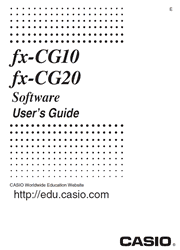PRIZM is revolutionary among graphing calculators with features that enhance users understanding of mathematics. With conventional graphing calculators, students learn by inputting equations to create graphs. PRIZM creates a whole new way to learn math by enabling students to experiment by creating their own graphs over pictures of real-life scenes, and then understand the functions from the graphs that they created on their own. (not C.A.S.)
Chapter 1 Basic Operation
1. Keys
2. Display
3. Inputting and Editing Calculations
4. Using the Math Input/Output Mode
5. Option (OPTN) Menu
6. Variable Data (VARS) Menu
7. Program (PRGM) Menu
8. Using the Setup Screen
9. Using Screen Capture
10. When you keep having problems…
Chapter 2 Manual Calculations
1. Basic Calculations
2. Special Functions
3. Specifying the Angle Unit and Display Format
4. Function Calculations
5. Numerical Calculations
6. Complex Number Calculations
7. Binary, Octal, Decimal, and Hexadecimal Calculations with Integers
8. Matrix Calculations
9. Vector Calculations
10. Metric Conversion Calculations
Chapter 3 List Function
1. Inputting and Editing a List
2. Manipulating List Data
3. Arithmetic Calculations Using Lists
4. Switching between List Files
5. Using CSV Files
Chapter 4 Equation Calculations
1. Simultaneous Linear Equations
2. High-order Equations from 2nd to 6th Degree
3. Solve Calculations
Chapter 5 Graphing
1. Sample Graphs
2. Controlling What Appears on a Graph Screen
3. Drawing a Graph
4. Saving and Recalling Graph Screen Contents
5. Drawing Two Graphs on the Same Screen
6. Manual Graphing
7. Using Tables
8. Modifying a Graph
9. Dynamic Graphing
10. Graphing a Recursion Formula
11. Graphing a Conic Section
12. Drawing Dots, Lines, and Text on the Graph Screen (Sketch)
13. Function Analysis
Chapter 6 Statistical Graphs and Calculations
1. Before Performing Statistical Calculations
2. Calculating and Graphing Single-Variable Statistical Data
3. Calculating and Graphing Paired-Variable Statistical Data (Curve Fitting)
4. Performing Statistical Calculations
5. Tests
6. Confidence Interval
7. Distribution
8. Input and Output Terms of Tests, Confidence Interval, and Distribution
9. Statistic Formula
Chapter 7 Financial Calculation
1. Before Performing Financial Calculations
2. Simple Interest
3. Compound Interest
4. Cash Flow (Investment Appraisal)
5. Amortization
6. Interest Rate Conversion
7. Cost, Selling Price, Margin
8. Day/Date Calculations
9. Depreciation
10. Bond Calculations
11. Financial Calculations Using Functions
Chapter 8 Programming
1. Basic Programming Steps
2. Program Mode Function Keys
3. Editing Program Contents
4. File Management
5. Command Reference
6. Using Calculator Functions in Programs
7. Program Mode Command List
8. CASIO Scientific Function Calculator Special Commands ?=? Text Conversion Table
9. Program Library
Chapter 9 Spreadsheet
1. Spreadsheet Basics and the Function Menu
2. Basic Spreadsheet Operations
3. Using Special Spreadsheet Mode Commands
4. Conditional Formatting
5. Drawing Statistical Graphs, and Performing Statistical and Regression Calculations
6. Spreadsheet Mode Memory
Chapter 10 eActivity
1. eActivity Overview
2. eActivity Function Menus
3. eActivity File Operations
4. Inputting and Editing Data
Chapter 11 Memory Manager
1. Using the Memory Manager
Chapter 12 System Manager
1. Using the System Manager
2. System Settings
Chapter 13 Data Communication
1. Performing Data Communication between the Calculator and a Personal Computer
2. Performing Data Communication between Two Calculators
3. Connecting the Calculator to a Projector
Chapter 14 Geometry
1. Geometry Mode Overview
2. Drawing and Editing Objects
3. Controlling the Appearance of the Geometry Window
4. Using Text and Labels in a Screen Image
5. Using the Measurement Box
6. Working with Animations
Chapter 15 Picture Plot
1. Picture Plot Function Menus
2. Managing Picture Plot Files
3. Using the Plot Function
4. Using the Plot List
5. Common Functions with the Graph Mode
Appendix
1. Error Message Table
2. Input Ranges
E-Con2 Application (English)
1. E-Con2 Overview
2. Using the Setup Wizard
3. Using Advanced Setup
4. Using a Custom Probe
5. Using the MULTIMETER Mode
6. Using Setup Memory
7. Using Program Converter
8. Starting a Sampling Operation
9. Using Sample Data Memory
10. Using the Graph Analysis Tools to Graph Data
11. Graph Analysis Tool Graph Screen Operations
12. Calling E-Con2 Functions from an eActivity
